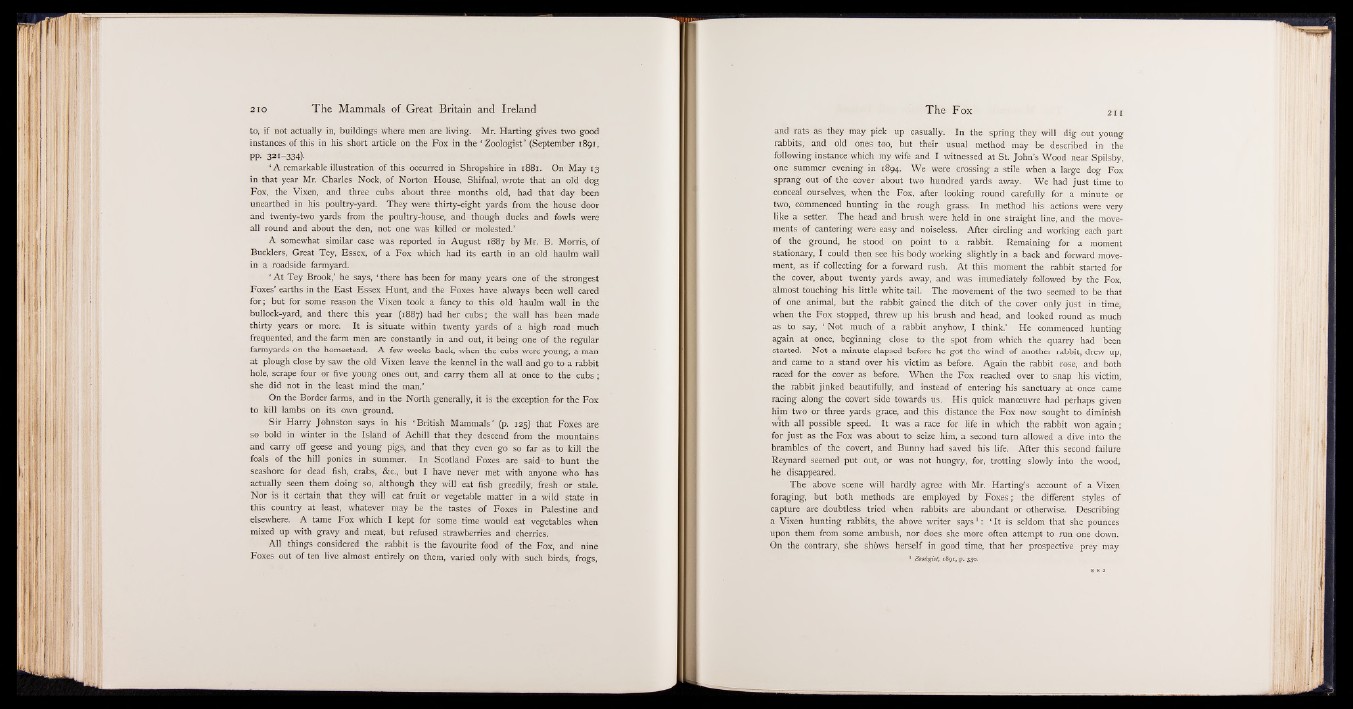
to, if not actually in, buildings where men are living. Mr. Harting gives two good
instances of this in his short article on the Fox in the ‘ Zoologist’ (September 1891,
pp. 321-334).
‘A remarkable illustration of this occurred in Shropshire in 1881. On May 13
in that year Mr. Charles Nock, of Norton House, Shifnal, wrote that an old dog
Fox, the Vixen, and three cubs about three months old, had that day been
unearthed in his poultry-yard. They were thirty-eight yards from the house door
and twenty-two yards from the poultry-house, and though ducks and fowls were
all round and about the den, not one was killed or molested.’
A somewhat similar case was reported in August 1887 by Mr. B. Morris, of
Bucklers, Great Tey, Essex, of a Fox which had its earth in an old haulm wall
in a roadside farmyard.
‘ At Tey Brook,’ he says, ‘ there has been for many years one of the strongest
Foxes’ earths in the East Essex Hunt, and the Foxes have always been well cared
for; but for some reason the Vixen took a fancy to this old haulm wall in the
bullock-yard, and there this year (1887) had her cubs; the wall has been made
thirty years or more. It is situate within twenty yards of a high road much
frequented, and the farm men are constantly in and out, it being one of the regular
farmyards on the homestead. A few weeks back, when the cubs were young, a man
at plough close by saw the old Vixen leave the kennel in the wall and go to a rabbit
hole, scrape four or five young ones out, and carry them all at once to the cubs;
she did not in the least mind the man.’
On the Border farms, and in the North generally, it is the exception for the Fox
to kill lambs on its own ground.
Sir Harry Johnston says in his ‘ British Mammals’ (p. 125) that Foxes are
so bold in winter in the Island of Achill that they descend from the mountains
and carry off geese and young pigs, and that they even go so far as to kill the
foals of the hill ponies in summer. In Scotland Foxes are said to hunt the
seashore for dead fish, crabs, &c., but I have never met with anyone who has
actually seen them doing so, although they will eat fish greedily, fresh or stale.
Nor is it certain that they will eat fruit or vegetable matter in a wild state in
this country at least, whatever may be the tastes of Foxes in Palestine and
elsewhere. A tame Fox which I kept for some time would eat vegetables when
mixed up with gravy and meat, but refused strawberries and cherries.
All things considered the rabbit is the favourite food of the Fox, and nine
Foxes out of ten live almost entirely on them, varied only with such birds, frogs,
and rats as they may pick up casually. In the spring they will dig out young
rabbits, and old ones too, but their usual method may be described in the
following instance which my wife and I witnessed at St. John’s Wood near Spilsby,
one summer evening in 1894. We were crossing a stile when a large dog Fox
sprang out of the cover about two hundred yards away. We had just time to
conceal ourselves, when the Fox, after looking round carefully for a minute or
two, commenced hunting in the rough grass. In method his actions were very
like a setter. The head and brush were held in one straight line, and the movements
of cantering were easy and noiseless. After circling and working each part
of the ground, he stood on point to a rabbit. Remaining for a moment
stationary, I could then see his body working slightly in a back and forward movement,
as if collecting for a forward rush. At this moment the rabbit started for
the cover, about twenty yards away, and was immediately followed by the Fox,
almost touching his little white tail. The movement of the two seemed to be that
of one animal, but the rabbit gained the ditch of the cover only just in time,
when the Fox stopped, threw up his brush and head, and looked round as much
as to say, ‘ Not much of a rabbit anyhow, I think.’ He commenced hunting
again at once, beginning close to the spot from which the quarry had been
started. Not a minute elapsed before he got the wind of another rabbit, drew up,
and came to a stand over his victim as before. Again the rabbit rose, and both
raced for the cover as before. When the Fox reached over to snap his victim,
the rabbit jinked beautifully, and instead of entering his sanctuary at once came
racing along the covert side towards us. His quick manoeuvre had perhaps given
him two or three yards grace, and this distance the Fox now sought to diminish
with all possible speed. It was a race for life in which the rabbit won again;
for just as the Fox was about to seize him, a second turn allowed a dive into the
brambles of the covert, and Bunny had saved his life. After this second failure
Reynard seemed put out, or was not hungry, for, trotting slowly into the wood,
he disappeared.
The above scene will hardly agree with Mr. Harting’s account of a Vixen
foraging, but both methods are employed by Foxes; the different styles of
capture are doubtless tried when rabbits are abundant or otherwise. Describing
a Vixen hunting rabbits, the above writer says1 : ‘ It is seldom that she pounces
upon them from some ambush, nor does she more often attempt to run one down.
On the contrary, she shows herself in good time, that her prospective prey may
1 Zoologist, 1891, p. 330.